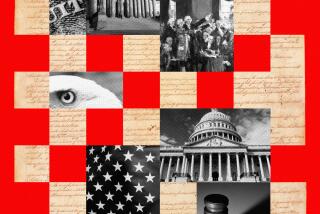Constitution Bicentennial Planners Faced With Apathy After Gala for Statue’s 100th
- Share via
WASHINGTON — Two hundred years ago this week, in what one archivist calls “the most successful failure in American history,” a dozen delegates from five states met in a tavern near the Maryland State House in Annapolis.
Unable to draft the trade agreement that was the original purpose of the meeting, the 12 men decided to undertake a bold gamble: To remedy the “important defects in the system” of national government, they agreed to promote a plan to have all 13 of the states appoint commissioners to an effort “to render the constitution of the federal government adequate to the exigencies of the union.”
The Annapolis trade convention thus led directly to the drafting of the United States Constitution in Philadelphia the next summer.
The 200th anniversary of that first meeting opens the nation’s bicentennial celebration of its Constitution this week, yet the tavern assembly was not a moment in history that burns in the memory or stirs emotion. Thus it also has come to symbolize a major problem of the four-year-long observance.
Attitude of Indifference
When Chief Justice Warren E. Burger announced in June that he was retiring from the Supreme Court to devote full time to planning the celebration, few people seemed to care.
“The reaction we’ve gotten is, ‘Didn’t we do this 10 years ago?’ ” said Darrel deChaby, a spokesman for the National Endowment for the Humanities, which for several years has sponsored scholarly meetings and publications to drum up interest in the celebration.
Unlike the 200th anniversary of the Declaration of Independence in 1976, which featured parades of tall ships, “Bicentennial Minute” spots on television and a Fourth of July extravaganza, this nationwide observance will “play down the bells and whistles,” planners say.
They point out that while the Declaration of Independence is a ringing, revolutionary proclamation, the Constitution is a more subtle document, a product of delicate political compromise.
“This celebration should have a different character. We want to call attention to the ideas and principles of government that the Constitution embodied,” said Cynthia Harrison, deputy director of Project 87, a joint effort of the American Historical Assn. and the American Political Science Assn. “This won’t be just the sheer celebration of a historical event.”
Four-Year Observance
Indeed this is true, in part because there is not just one historical event to be celebrated. The Constitution was developed over four years, from a meeting in Philadelphia in the summer of 1787, to its ratification by the states in 1788, to the installation of President George Washington in 1789. Probably the best-known portion of the Constitution, the Bill of Rights, was not added until 1791.
Thus, while schoolchildren will spend extra time studying the Constitution in the next few years--to judge by the number of teacher plans, film strips and essay contests being planned--adults lack a single time and place in history on which to focus their attention.
Burger’s resignation, timed to give the celebration a publicity boost, was met with widespread skepticism. Gene Mater, a retired CBS-TV executive who has joined Burger in his new venture, said, however, that Burger is “very serious about this. He thinks this is an opportunity to have Americans really appreciate the Constitution.”
Nonetheless, Mater also is aware of the difficulty of inspiring public interest in what Burger refers to as a “civics lesson for the nation,” one that also opens just months after the fireworks for the Statue of Liberty’s 100th birthday faded from view.
Confused With Statue Project
As Mater explained the problems of the Constitution bicentennial in a recent interview, his telephone rang:
“No, I’m sorry. We have nothing to do with Liberty Weekend. We’re the Constitution,” he said, barely dissembling exasperation. “You’ll have to call Lee Iacocca’s operation in New York.”
He hung up, and said: “That’s what we’re facing. A magazine writer who doesn’t know the difference between the Statue of Liberty celebration and the bicentennial of the Constitution.”
Not only did the restoration of the statue steal the public’s attention--and perhaps satisfy its appetite for patriotic celebration--it also soaked up a lot of money.
Bicentennial commission officials estimate that the statue extravaganza spent $280 million. Congress has limited the Constitution commission to a budget of $12 million through 1989. To avoid the complaints of over-commercialization that beset both the 1976 celebration and the 1984 Los Angeles Olympics, the Constitution bicentennial office also was forbidden to accept corporate gifts of more than $100,000 a year or to sell its logo.
Burger is seeking to have those restrictions lifted and to have the appropriation doubled to $24 million, but legislation to make those changes is still pending in the Senate.
“I’m sure Congress has a lot of other things that seem more pressing to worry about,” one commission official said.
New ‘Bicentennial Minutes’
Still, the bicentennial’s supporters believe that most Americans will hear something of this event. Mater says that his former employer, CBS, has agreed to begin broadcasting a new set of “Bicentennial Minutes” in October. And public television has planned a six-part series on the Constitution that will be aired next year.
Scholars suggest that the Constitution is not appreciated perhaps because it has worked so well.
“We tend to think of democracy as a naturally good thing,” said Ralph Rossum, a professor of government at Claremont McKenna College in Claremont, Calif. “but the framers were suspicious of it. It was a problematic concept in 1787. Democracy in many other cases had degenerated into anarchy or tyranny.”
In the two centuries since the convention in Philadelphia, historians point out, the political world has seen many revolutions, but few stable democracies have developed from them. Moreover, they add, many Americans today do not understand the despair that settled on the young nation’s political leaders in the years following the Revolutionary War.
Old System Failed
Alexander Hamilton described the mid-1780s as a period of “national humiliation.” The loose confederation of 13 states had already proven unworkable, and each state, acting as a sovereign nation, had established its own currency. The states squabbled over the use of the rivers that flowed between them and set tariffs on products crossing interstate borders.
“If you want a parallel to the Articles of Confederation, think of the United Nations,” Rossum said.
Congress in the mid-1780s was little more than a debating society, much as the U.N. is today, he said. No executive had any real power, and a single state could veto any action of Congress. Since the last battles of the Revolution had ended five years earlier, states had refused to pay taxes to support the Army and Navy. Spanish ships took control of the lower Mississippi River and the British occupied forts near the Great Lakes.
The Annapolis convention, Sept. 11-14, 1786, was called in the hope of arranging interstate trade along the lines of today’s Common Market in Europe. Two of the 12 delegates--Hamilton of New York and James Madison of Virginia--were convinced that the weaknesses of the confederation went well beyond commerce, however.
For political thinkers such as Madison, the governmental plan needed to confront “two evils, tyranny and ineptitude,” Rossum said. The system under the Articles of Confederation had proven itself inept, but an unrestrained executive or legislative branch could lead to a “tyranny of a democratic majority,” as Madison put it.
State Rivalries Addressed
To the political realists who convened later in Philadelphia, the debate turned on the powers of the large states versus the rights of the smaller ones. A compromise between the two created a House of Representatives with a membership weighted according to state population and a Senate in which each state was equally represented.
Four months of debate in Philadelphia yielded a plan for three branches of government, each with its own powers. Certain powers also were reserved to the states, and still others were reserved to the citizens.
Years later, the document was recognized as a work of political genius.
More to Read
Sign up for Essential California
The most important California stories and recommendations in your inbox every morning.
You may occasionally receive promotional content from the Los Angeles Times.











